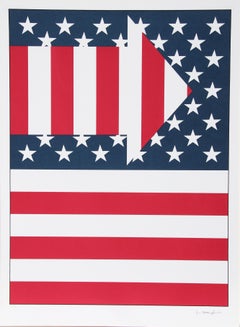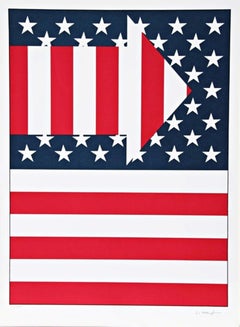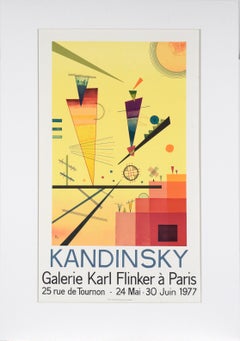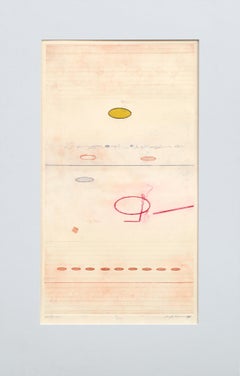Paul von Ringelheim Abstract Prints
to
1
1
Overall Width
to
Overall Height
to
1
1
12
637
205
165
164
2
2
2
2
1
2
Artist: Paul von Ringelheim
American Flag III, Pop Art Screenprint by Paul von Ringelheim
By Paul von Ringelheim
Located in Long Island City, NY
Artist: Paul von Ringelheim, Austrian/American (1933 - 2003)
Title: American Flag III
Year: 1979
Medium: Serigraph, signed and numbered in penicl
Edition: 300
Paper Size: 34 in. x 2...
Category
1970s Pop Art Paul von Ringelheim Abstract Prints
Materials
Screen
American Flag III (Geometric Abstraction Hard Edge Minimalist Abstraction) S/N
By Paul von Ringelheim
Located in New York, NY
PAUL VON RINGELHEIM
American Flag III, 1979
Silkscreen in Colors on wove paper
Signed and numbered in graphite pencil on the lower margin front
31 × 23 inches
Unframed
Hand signed and numbered from the limited edition of 300.
Born in Vienna Austria, but working in the US for many decades, Von Ringelheim, also known as a sculptor, brought his unique hard-edge minimalistic geometric abstraction outsider's take on the American Flag to this vintage 1970s limited edition, signed silkscreen. Unframed and in fine condition. Ringelheim was represented in the 1960s by the legendary Rose Fried Gallery...
Category
1970s Abstract Geometric Paul von Ringelheim Abstract Prints
Materials
Screen
Related Items
Kandinsky at Galerie Karl Flinker - 1977 Exhibition Poster - in Ink on Paper
By Wassily Kandinsky
Located in Soquel, CA
Kandinsky at Galerie Karl Flinker - 1977 Exhibition Poster - in Ink on Paper
Poster with a reproduction of "Merry Structure" by Vassily Kandinsky (Russian, 1866-1944). This posted i...
Category
1970s Abstract Geometric Paul von Ringelheim Abstract Prints
Materials
Paper, Ink, Lithograph
$750
H 40 in W 28 in D 0.25 in
"Orange Row", Abstract Geometric Minimalist Composition w Ovals, Limited Edition
By Geoffrey Bowman
Located in Soquel, CA
"Orange Row", Abstract Geometric Minimalist Composition w Ovals, Limited Edition
Delicate and perfect ovals in orange, yellow, red, and blue are purposefully arranged on lined paper...
Category
1990s Abstract Geometric Paul von Ringelheim Abstract Prints
Materials
Paper, Ink, Lithograph, Etching
$556 Sale Price
20% Off
H 32 in W 20 in D 0.25 in
Cardbirds, 1972 exhibition, rare original red poster, Robert RAUSCHENBERG
By Robert Rauschenberg
Located in Brooklyn, NY
Robert RAUSCHENBERG
Cardbirds, 1972 exhibition, rare original poster
For the exhibition "Cardbirds" at the Sonnabend Gallery
Signed in the plate framed in walnut.
21 x26.5" framed.
...
Category
1970s Pop Art Paul von Ringelheim Abstract Prints
Materials
Screen
$1,000 Sale Price
60% Off
H 26 in W 21 in
Original World Cup USA 94 - Coca Cola Soccer poster
Located in Spokane, WA
Original World Cup USA ’94, Coca Cola sponsored vintage poster. Archival linen backed in A- condition, ready to frame. This World Cup ’94 poster is very rarely seen or available....
Category
1990s Abstract Geometric Paul von Ringelheim Abstract Prints
Materials
Offset
Modern Print /// Roy Lichtenstein Pop Art Abstract Geometric MoMA Gemini G.E.L.
By Roy Lichtenstein
Located in Saint Augustine, FL
Artist: Roy Lichtenstein (American, 1923-1997)
Title: "Modern Print"
*Numbered, signed, and dated by Lichtenstein in pencil lower right
Year: 1971
Medium: Original Lithograph and Scr...
Category
1970s Pop Art Paul von Ringelheim Abstract Prints
Materials
Lithograph, Screen
V (from Double Metamorphosis Series) Large Abstract Screen Print
By Yaacov Agam
Located in Aventura, FL
Screen print on arches paper. From Double Metamorphosis Series. Hand signed and numbered by Yaacov Agam. From the edition of 180. Sheet size 36.25 x 49.75 inches. Image size 29 ...
Category
1970s Abstract Paul von Ringelheim Abstract Prints
Materials
Paper, Screen
$3,400 Sale Price
20% Off
H 41 in W 55 in D 1 in
Japanese Fishing Boats, Abstract Diptych Screen Print
Located in Soquel, CA
Abstract Screen print (Serigraph) composition of Japanese fishing boats in two parts by an unknown artist (20th Century). Signed (possibly "Myketo") a...
Category
Late 20th Century Abstract Paul von Ringelheim Abstract Prints
Materials
Paper, Ink, Screen
$2,500
H 31.5 in W 36 in D 4 in
Julian Schnabel 'Invierno Primaveral' (Sexual Spring-like Winter)
By Julian Schnabel
Located in New York, NY
Julian Schnabel
Invierno Primaveral, 1995
Hand-painted, 17-color screenprint with poured resin
40 x 30 inches (102 x 76 cm)
Edition of 80 signed in pencil and stamped on verso
"S...
Category
1990s Abstract Paul von Ringelheim Abstract Prints
Materials
Screen
Hero as a Riddle by Eduardo Paolozzi gold silver pop art with Basquiat style
By Eduardo Paolozzi
Located in New York, NY
Hero as a Riddle (1963) depicts a smiling head printed in gold, silver, and black. The shapes and lines composing the figure’s face are architectural and geometric: the eyes are comp...
Category
1960s Pop Art Paul von Ringelheim Abstract Prints
Materials
Screen
$2,650
H 39.5 in W 29.5 in
Steve Kaufman "Abraham Lincoln" 1990 Artist Proof Serigraph, Hand Signed Verso
By Steve Kaufman
Located in Miami, FL
STEVE KAUFMAN – "ABRAHAM LINCOLN"
⚜ Serigraph on Canvas ⚜ Initialed Verso ⚜ Edition 48/50 AP ⚜ Black Float Frame
VIBRANT POP ICONOGRAPHY OF AN AMERICAN LEGEND
This bold 1990 serigra...
Category
1990s Pop Art Paul von Ringelheim Abstract Prints
Materials
Screen, Canvas
$3,200
H 19.5 in W 15.125 in D 2 in
Olympische Spiele Muenchen (Foot), Pop Art Screenprint Poster by Tom Wesselmann
By Tom Wesselmann
Located in Long Island City, NY
Artist: Tom Wesselmann (1931 - 2004)
Title: Olympische Spiele Muenchen (Foot)
Year: 1972
Medium: Screenprint Poster mounted on linen
Edition: 3000
Size: 40 in. x 25 in. (101.6 cm x 6...
Category
1970s Abstract Expressionist Paul von Ringelheim Abstract Prints
Materials
Screen
"Nobility" 180/300 Signed Color Serigraph of Abstract Horse and Woman with Lute
By Tiefeng Jiang
Located in Austin, TX
Serigraph on paper
Page Size: 12 x 12 in.
Gold Leaf Frame Size: 21 x 21 in.
Hand Signed, bottom right in black marker
Hand Numbered, bottom left in black marker "180/300"
This strik...
Category
1990s Pop Art Paul von Ringelheim Abstract Prints
Materials
Archival Paper, Screen
Previously Available Items
American Flag III, Pop Art Screenprint by Paul von Ringelheim
By Paul von Ringelheim
Located in Long Island City, NY
Artist: Paul von Ringelheim, Austrian/American (1933 - 2003)
Title: American Flag III
Year: 1979
Medium: Serigraph, signed and numbered in penicl
Edition: 300
Paper Size: 34 in. x 2...
Category
1970s Pop Art Paul von Ringelheim Abstract Prints
Materials
Screen
Paul Von Ringelheim abstract prints for sale on 1stDibs.
Find a wide variety of authentic Paul von Ringelheim abstract prints available for sale on 1stDibs. You can also browse by medium to find art by Paul von Ringelheim in screen print and more. Much of the original work by this artist or collective was created during the 1970s and is mostly associated with the Pop Art style. Not every interior allows for large Paul von Ringelheim abstract prints, so small editions measuring 23 inches across are available. Customers who are interested in this artist might also find the work of Nicholas Krushenick, Anne Youkeles, and Harvey Daniels. Paul von Ringelheim abstract prints prices can differ depending upon medium, time period and other attributes. On 1stDibs, the price for these items starts at $800 and tops out at $950, while the average work can sell for $875.



